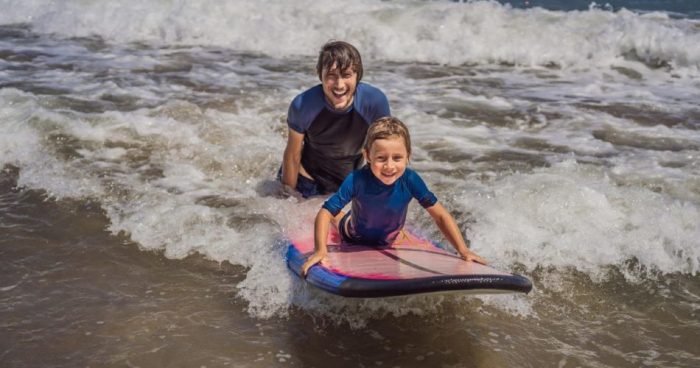Surfing basics are the foundation for riding the waves like a pro, dude! From understanding the origins of surfing to mastering balance and stance, get ready to dive into the world of wave-riding adventure.
Let’s explore the essential equipment needed, types of surfboards, surfing techniques, and proper etiquette to make your surfing experience smooth and epic.
Surfing Basics

Surfing is a water sport where individuals ride waves on a surfboard. It originated in Polynesia and was later popularized in Hawaii. Today, surfing is enjoyed by people all over the world.
Essential Equipment
When it comes to surfing, having the right equipment is crucial. Some essential items include a surfboard, leash, wetsuit, and wax. The surfboard is used for riding the waves, while the leash keeps the board attached to the surfer. The wetsuit provides insulation and protection from the cold water, and the wax is applied to the board for better grip.
Balance and Stance
Maintaining balance and the correct stance are key principles in surfing. Proper balance is essential for staying upright on the board and maneuvering through the waves. The proper stance involves positioning your feet shoulder-width apart, with your knees slightly bent and your weight centered on the board. By mastering these basics, you can improve your surfing skills and enjoy the thrill of riding the waves.
Types of Surfboards: Surfing Basics

Longboards and shortboards are two popular types of surfboards that cater to different surfing styles. Longboards are typically longer in length, providing stability and ease of paddling, making them ideal for beginners or riders looking for a smooth and relaxed surfing experience. On the other hand, shortboards are shorter and more maneuverable, allowing for quick turns and tricks, making them suitable for more experienced surfers who prefer a fast-paced and dynamic surfing style.
Fish Surfboard
A fish surfboard is a type of surfboard characterized by its wide and flat shape, resembling the silhouette of a fish. This design allows for increased speed and maneuverability in smaller waves, making it perfect for surfing in mushy or less powerful conditions. Fish surfboards are great for intermediate to advanced surfers looking to have fun and improve their performance in smaller waves.
Soft-Top Surfboard for Beginners
Soft-top surfboards are surfboards with a foam deck that provides extra cushioning and safety for beginners learning to surf. The soft-top design is forgiving and reduces the risk of injury while practicing basic surfing techniques. These surfboards are stable, buoyant, and easy to paddle, making them an excellent choice for novice surfers looking to build confidence in the water.
Surfing Techniques
When it comes to surfing, mastering the right techniques is crucial for success in the water. From paddling out to catching waves and executing turns, each step plays a vital role in your surfing experience.
Paddling Out to the Lineup
Paddling out to the lineup is the first step in getting ready to catch some waves. To do this effectively, you need to navigate through the breaking waves by paddling out past them. It’s essential to time your paddle-outs between sets to avoid getting caught inside. Once you reach the lineup, position yourself properly to catch the best waves.
Catching a Wave and Popping Up, Surfing basics
Catching a wave is an exhilarating experience that requires timing and skill. As you see a wave approaching, start paddling to match its speed. Once you feel the wave picking you up, pop up quickly to your feet while maintaining your balance. The key is to stay low and centered on your board to ride the wave smoothly.
Turning Techniques: Bottom Turns and Cutbacks
Turning on a wave is essential for maneuvering and controlling your ride. Bottom turns are crucial for setting up your line and generating speed. To execute a bottom turn, lean into the wave and use your body and rail to carve a smooth arc. Cutbacks, on the other hand, involve redirecting your board back towards the breaking part of the wave. By shifting your weight and pivoting your board, you can perform stylish cutbacks that add flair to your surfing.
Surfing Etiquette
When it comes to surfing etiquette, it’s all about respect for your fellow surfers and the environment. By following the unspoken rules of the lineup and understanding right of way rules, you can ensure a positive surfing experience for everyone. Additionally, environmental conservation plays a crucial role in preserving the beauty of surfing areas for future generations.
Respecting Other Surfers in the Lineup
- Give right of way to surfers who are already riding a wave.
- Avoid dropping in on someone else’s wave, wait your turn in the lineup.
- Communicate with other surfers using gestures or calls to prevent collisions.
- Respect the local surfers and the hierarchy in the lineup.
Right of Way Rules
- The surfer closest to the peak of the wave has the right of way.
- Avoid snaking or cutting off other surfers to catch a wave.
- When paddling out, give way to surfers riding the wave to avoid interference.
- Be aware of your surroundings and always yield to others to prevent accidents.
Importance of Environmental Conservation
- Never litter or pollute the ocean, always dispose of trash properly.
- Respect marine life and avoid disrupting their natural habitats.
- Participate in beach clean-ups and support organizations that protect the ocean.
- Be mindful of your carbon footprint and reduce your impact on the environment.